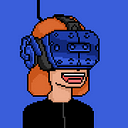The Haptics Industry: Overview, Potential, and Market Outlook
Haptic technology is being actively incorporated into augmented reality (AR) and virtual reality (VR) experiences, wearables, advertising, and simulation equipment. What’s behind the technology that is expected to reach a worth of $10 Billion by 2026?
Haptic technology and science studies the transmission and understanding of information through touch. In particular, the concept refers to tactile sensations in interfaces.
Although this might sound slightly alien, we’re already using haptic technology in our devices. For example, we experience it when a phone vibrates or a game controller rumbles. These are examples of excellent haptic feedback that enhance a user’s experience.
We tend to underestimate the importance of touch. However, touch complements our limited field of vision and is behind a lot of the activities that define us as humans. We express emotion through touch, and it also helps create our sense of body ownership or presence.
There’s a misconception that introducing haptics into games and devices can only serve to increase the realism of virtual experiences. However, these tools are an excellent way to improve the user experience in general, as it’s proven that haptics reduce completion times and error rates.
It wasn’t until recently that electronic devices and virtual experiences began incorporating haptics into their development. This is how that happened.
A Brief Overview of Haptics
The first uses of haptic technology were servomechanism systems that alerted aircraft pilots by making their controls vibrate when the plane approached a stall. By 1976, SEGA’s “Moto-Cross” variant, “Fonz,” had already tried haptic feedback to make handlebars vibrate during collisions.
In 1994, the company Aura Systems developed a belt that converted bass sound waves into vibrations, and in 1995 Thomas Massie developed the PHANToM, with which a person could feel objects on a computer screen by inserting their fingers into computerized arms.
Apple was the first company to use skin tap sensing to deliver notifications to the wearers of their Apple Watches in 2005. A number of applications followed, mostly for gaming consoles. Among them we can find Nintendo Switch’s Joy-Con, which uses Alp actuators, gaming headphones Razer Nari Ultimate, and the 2020 Sony PlayStation 5 controllers with resistance trigger controls that simulate resistance.
Haptics today also use microfluidics, friction modulation, and levers to exert force on the body or limbs of a user. For example, haptic gloves can measure how the skin of a hand stretches or contracts when someone lifts an object. When the object is pressed, the gloves can also measure the pressure exerted on it.
Ultrasound or lasers can be used as well to create tactile sensations in mid-air without the need for the user to be in contact with a surface. UK-based company Ultraleap, for example, can track a hand’s movements in 3D with unparalleled accuracy and near-zero latency.
The Potential of Haptics
Haptics are becoming essential for performing complex tasks via telepresence. The Shadow Hand, an advanced robotic hand with 129 touch sensors for every joint and finger pad, helps operators perform tasks at a distance. Early prototypes have been seen in NASA’s collection of robonauts. Simulators and flight simulators also benefit from force feedback that can significantly enhance training.
Haptics are rapidly gaining acceptance as a key part of virtual reality systems. Several companies are working on full-body or torso haptic vests or suits that would allow for users to feel explosions and bullet impacts. Or, in the case of the latest Disney initiatives, hugs and pinches.
Haptic feedback not only better simulates what it would feel like to touch or interact with something in real life but can also provide more subtle feedback. That’s why the technology has been deemed particularly revolutionary for robotic semiconductor assembly, surgical assistance, and sensitive manufacturing applications. In healthcare, haptic controls can help trainee surgeons carry out virtual operations reducing the risk of injuring a human being.
The potential of haptic technology is almost limitless, and the benefits are immediate. We all understand the language of touch, as haptic advances are much more straightforward (and literally palpable) than visuals or sound.
The Market Outlook
According to research from Market Insights, the haptics technology sector is expected to hit $10 billion by 2026, at a CAGR of 7%.
Among the main drivers are consumer demand in gaming, devices like tablets and smartphones, and automakers using 3D touchscreen displays and communications. Haptic actuator hardware and associated technology, after all, is built into over a billion devices each year.
Although the global economy has declined due to the COVID-19 pandemic, which has shut down manufacturing facilities and distribution hubs, the market is expected to grow steadily after 2021. Among the companies that will be driving haptics are Immersion Corporation, Force Dimension, Geomagic, Inc., HaptX Inc., Hapton S.A., MK Electronics, and Texas Instruments Inc.
Due to its increased use in robotics and healthcare, the force feedback segment accounted for almost 30% of the 2019 market. Higher demand for robotics will undoubtedly rise that of haptics as well.
Haptics are also considered key in the automotive space, with systems like driver alerts and entertainment options. Even the textile industry is considering haptics to allow customers to feel the texture of clothing through the internet.
Developers are expected to break from gloves and game controllers and delve deeper into innovative ways to convey and use the sense of touch. Consequently, haptics promise to boost the tech industry while drastically changing the way we work, drive, and play.
This article was originally published in Startup Savant under the title “The Haptics Industry Could Be Worth $10 Billion by 2026” (and with a different featured image) on October 20, 2020. Link: https://startupsavant.com/news/haptics-industry-could-be-worth-ten-billion-by-2026
